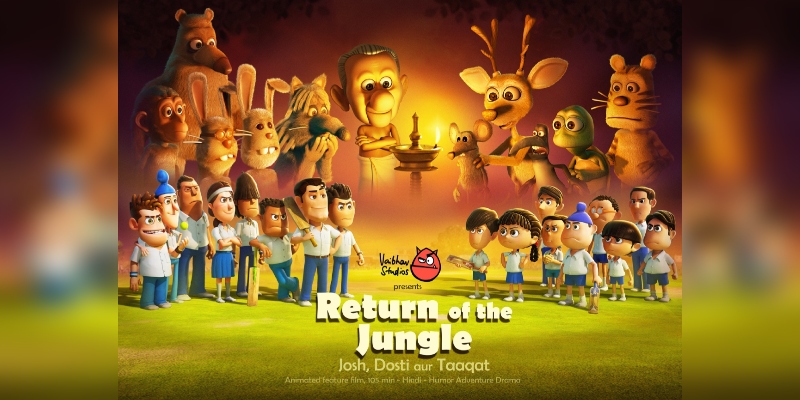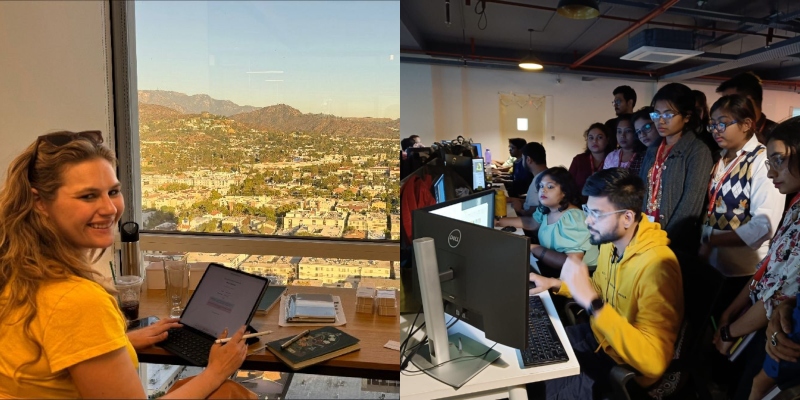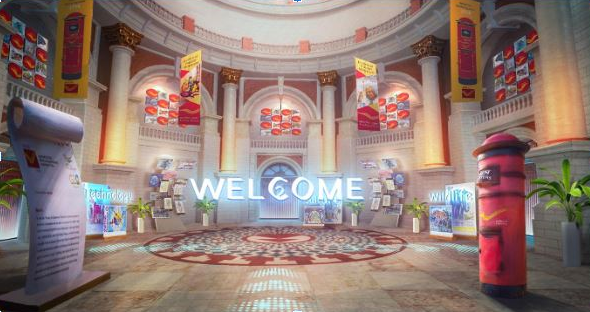In 2023, the Indian animation industry showcased remarkable resilience in the face of global challenges. The Writer’s Strike in Hollywood had reverberations across the entertainment sector worldwide, causing job losses. Despite this, industry leaders reflected on the year with satisfaction, citing steady progress in new project development, collaborations, and expansion as signs of overall growth.
According to the FICCI EY Report 2023, the Indian animation segment surged by 25 per cent, reaching Rs 38 billion in 2022 and was anticipated to hit Rs 46 billion in 2023.
Notable milestones marked the year’s success. Graffiti Multimedia’s series, KTB Bharat Hain Hum, created by Munjal Shroff and Tilak Shetty, debuted on Netflix, Prime Video and Doordarshan. This series illuminates the heroes of India’s freedom struggle. Vaibhav Kumaresh’s highly awaited 3D animated feature, Return of the Jungle, premiered at the International Film Festival of India (IFFI) in Goa, receiving an overwhelmingly positive response. Moreover, PunToon Kids’ episodes began airing on Doordarshan, marking significant achievements in the animation landscape.
The industry’s accomplishments don’t stop there. Global studio M2 Animation inaugurated its first India office in Mumbai. The company already has offices in Denmark, Bangkok and LA. Mumbai-based 88 Pictures ventured into VFX and revealed its work on its first project Mission Majnu – a Hindi feature film starring actor Siddharth Malhotra. The studio – known for its work in Kung Fu Panda: The Dragon Knight, Trollhunters – opened its first international office in Toronto, Canada. But the development that takes the centre stage is the studio delivering a short for the series Star Wars: Visions Volume 2 airing on Disney+ Hotstar. At AnimationXpress’ event Animation & More Summit, 88 Pictures founder & CEO Milind D. Shinde spoke about landing work on the project and explained the kind of research that went into creating the episode.

Animation Xpress conducted insightful interviews with various animation studios, offering a comprehensive view of the industry’s highs, lows and the prevailing landscape. These achievements stand as testament to the industry’s upward trajectory and its ability to set new standards.
Growth and industry revenues
In 2023, Charuvi Design Labs (CDL) grew 30 per cent YOY in terms of revenue. Toonz Media Group maintained progress in terms of new project development and collaborations. Zebu Animation Studios saw an increase in its top line by four to five per cent in 2023, despite the business slump across the industry due to the Writers’ Strike. Reliance Animation Studio CEO Tejonidhi Bhandare mentioned that they experienced significant growth in both new projects and revenue.
Current and upcoming projects
Fairly young Chennai-based studio Saffronic delivered the first season of Gabby’s Dollhouse for DreamWorks and its first short feature for Trioscope this year. The studio has some projects coming up in collaboration with Trioscope, Mindshow and WildBrain.
The year saw the theatrical release of Toonz’s flagship animated feature film The Canterville Ghost in the UK and the USA. The studio recently greenlit Season 3 of its popular show Zoonicorn, and is working on a range of TV series for both Indian and international audiences. These include Creepy Candy, Misfit Mansion, CID Squad, Aqua and more.
Noida-based Digitoonz began work on 16 2D and six 3D projects in 2023, including two animated feature films. “2023 was really big in terms of the projects as well as the revenue,” said Digitoonz founder and CEO Vikas Kumar.
Bengaluru-based Mikros Animation – part of Technicolor Creative Studios – worked on their first end-to-end DreamWorks animation feature film Orion and the Dark for Netflix. The studio’s other major projects include Kung Fu Panda: The Dragon Knight, Nickelodeon’s Star Trek: Prodigy and Paramount Pictures’ Paw Patrol: The Mighty Movie.
CDL’s animated feature The Legend of Prahlad: Narasimha Awakens was privately screened at Brussels, Belgium this year. The studio is working on its graphic novels, artwork and installations as well as content development projects for museums across India. CDL has in the works animated and live-action TV shows and pilots, including The Legend of Hanuman for Graphic India. Of the two short films the studio is working on, one will be out in January 2024 and the other in the second half of the year.
CDL founder Charuvi Agrawal said, “This year, we had the privilege of working on extremely technologically challenging projects, ranging from designing an immersive experience for a bus to a virtual museum interactive experience. We are looking to expand our team and infrastructure while developing our capabilities in the live-action CGI space.”

In 2023, Zebu undertook pre-production and focussed on its own IPs along with service projects. The company delivered Season 1 of Lego Dreamzzz which came out on Netflix this year, and is currently producing the show’s Season 2. The studio is working on an international theatrical feature film which is to be released soon.
Mumbai-based CGI animation studio Assemblage Entertainment is currently working on two global animated feature films – Stitch Head and Sneaks. Stitch Head is an animated comedy directed by Steve Hudson and Toby Genkel. The collaboration involving Aniventure, Gringo Films, and Fabrique d’Images is expected to be completed by the year 2025. Sneaks is produced by Len Hartman, Gil Cloyd, Laurence Fishburne and Helen Sugland. In 2023, Reliance Animation collaborated with Rohit Shetty Picturez and Warner Bros. Discovery to create Little Singham’s 3D tele-film Bahubali Friends – Rise of Aparshatru, which was screened at the International Film Festival of India (IFFI) in Goa.
Achievements and expansions
From setting new divisions to launching new initiatives, animation studios have achieved major milestones this year.
Assemblage expanded its operations in Bengaluru. Assemblage Entertainment CEO Arjun Madhavan said, “Recognising the city’s status as a thriving hub for innovation and a talent hotspot, we invested resources to strengthen our presence in this location. This move will not only allow us to tap into the diverse and skilled workforce available in the region but also enable us to foster collaborative partnerships with the local creative community.”
Zebu Animation Studios founder & creative director Veerendra Patil mentioned that his studio’s most important endeavour yet, the Datsi Foundation, set sail this year. The not-for-profit school has been started to give its students access to “real world experience, future-ready skills and global opportunities.”
Digitoonz, which has a presence in the Indian cities of Delhi-NCR and Kolkata as well as the US state of Delaware, set up an office in the US city of Los Angeles. The company doubled its Kolkata office space by moving into the city’s IT park location.

Toonz launched its feature film division in 2023, which will be involved in its in-house content as well as titles from other partners and third-party productions. “In the feature film segment, our focus is mainly in the kids and family entertainment genre in both animation and live-action,” shared Toonz Media Group CEO P Jayakumar.
Green Gold Animation expanded its services into visual effects, collaborating with Tollywood on various projects. The studio ventured into live-action with its feature film Chhota Bheem and the Curse of Damyaan, which it will launch under the newly inaugurated Chilaka Productions banner.
Saffronic recently set its footprint in Bengaluru, marking the city as its second location after Chennai. “We have flexible WFH and WFO policies as well,” highlighted Saffronic studio director Prabhakar Sambandan.
Challenges and adaptation strategies
The ripple effects of the WGA and SAG-AFTRA strikes, the general economic downturn, difficulties in wooing investors, shrinking budgets of broadcasters and keeping up with the rapidly evolving technologies were the major challenges that affected the entertainment industry in 2023.
Apart from that, “there is a significant drop in TV content production due to general decline in the TV industry worldwide,” Jayakumar said.
The biggest challenge is the reducing interest in kids animation by large studios leading to budgetary constraints, Agrawal felt. “This is also somewhat evident by the lacklustre performances of many of the big budget global animated films. This is a cycle and so it is indeed a matter of time when we get out of the trough,” she said. “As a studio, the challenges were linked primarily to controlling the increasing cost of premium animation. As better talent commands better remuneration, we need to optimise across the board to offer good value to producers and channels.”

According to Reliance Animation, rising production costs, changing consumer behaviour, global economic factors and shortage of skilled talent were some of the common challenges faced by the Indian animation industry.
Since broadcasters are tightening their budgets, animation studios need to navigate this challenge. “Handling tight budgets from broadcasters is like managing your money for the month – you need to be smart about it,” said Green Gold Animation founder & managing director Rajiv Chilaka. Toonz is optimising its spend by turning to automation, AI, and emerging technologies to improve its studio’s processes.
Reliance Animation is focusing on the below factors to cope with tight budgets:
- Efficient Production: Streamline workflows for cost-effectiveness.
- Strategic Partnerships: Collaborate to share costs and resources.
- Diversification: Explore new markets and content types.
- Technology Investment: Use technology to improve efficiency and reduce costs.
- Targeted Marketing: Increase visibility to attract better opportunities.
- Cost Management: Implement rigorous expense control measures.
- Adaptation to Trends: Align content with current market preferences.
- Flexible Formats: Consider cost-effective content formats.
- Long-Term Planning: Develop a strategic plan for sustained success.
Green Gold Animation found cost-effective solutions, optimised its workflow and ensured that every penny counts. In response to tight budgets, “our studio implemented efficient cost management strategies. This required adopting affordable technologies, carefully examining our manufacturing procedures, and making a commitment to streamlining our operations,” Chilaka said.
“While budgets are tight, we must realise that this is indeed the creative industry and that a very good idea and exceptional execution are always in demand. If your product is brilliant, there is always a buyer,” Agrawal added.
Chilaka pointed out, “We felt the heat of the technological challenge in 2023. Our studio put a lot of effort into improving and adapting.” He added, “The need for original and new content presented another challenge. Finding the ideal mix between what people enjoy and what’s novel and fascinating can be challenging.”
Overall progress and outlook
The industry veterans have mixed views on the growth of the animation sector in 2023.
As per FICCI EY Report 2023, Indian animation segment grew by 25 per cent to reach Rs 38 billion in 2022 and was predicted to reach Rs 46 billion in 2023.
Digitoonz’s Kumar stated that “this number is very much achievable” while Zebu’s Patil said, “Based on our estimate, we anticipate a growth of around 10 per cent in 2023 (Rs 42 billion) compared to 2022, despite the Writer’s Strike that persisted for almost six months. We foresee reaching Rs 50 billion in 2024 as a realistic and achievable prediction.”
Agrawal felt that the Indian animation industry will grow and perhaps faster than these numbers. “Animation in India is used in many sectors including film, TV, advertising, education and training, art, gaming, XR/AR/VR, etc. for the Indian market and for the global market. I won’t be surprised if these numbers are an underestimation. A ground up analysis is needed to get accurate data.”
Jayakumar said, “Starting from the macroeconomic situation to the series of strikes, the ripple effects were widely felt by the industry in India. In this backdrop, I doubt we will reach the predicted number in 2023.”
Bhandare found the report’s data encouraging which underscores the industry’s resilience and expanding market presence. He felt that the predicted growth to Rs 46 billion in 2023 suggested a positive trajectory, likely driven by increasing demand, technological advancements, and the industry’s ability to tap into global markets. “However, the actual rate of increase depends on various factors, including the continued demand for animated content, advancements in technology adoption, and the industry’s adaptability to evolving trends,” Bhandare remarked.
Jayakumar further mentioned that the Indian animation industry has shown promising signs of growth over the years. Indian animation studios and artists have received international recognition and collaborations with international studios and the outsourcing of animation projects have contributed to the industry’s global footprint.
Echoing the sentiment, Chilaka shared, “In recent years, there has been a notable increase in the production of high-quality animated content from India, and managed to gain popularity both domestically and internationally. This growth was only possible with the efforts of skilled artists, studios, and industry professionals who have consistently pushed their creative boundaries.”
“Over the last 25 years this industry has seen maximum growth both in terms of talent and technology,” said Saffronic studio director Kumar Chandrasekaran. “The talent continues to mature while the availability, deployment and use of the technology continues to grow and evolve. The quality of education for upcoming talent has also improved massively.”
Saffronic’s Prabhakar added, “The quality of artists, their pay scale, and the recently announced tax benefits for the animation industry will surely improve the industry further. However, the major concerns are a lack of awareness about taking animation as a mainstream job here in India compared to other developed countries. If more awareness and specialised courses are created, there is potential for India to become a hub for the global market.”
In 2023, the Indian animation industry showcased resilience and steady growth despite challenges like strikes and economic downturns. Diverse perspectives on growth projections reflect both optimism and caution.
While studios are cautious about investing in high-budget content, the industry is rapidly growing. Anticipated acceleration in growth, driven by maturing audiences and the rise of Indian animation intellectual property, signals a promising phase ahead.
Despite challenges, studios have expanded, diversified, and adapted, positioning India as a potential hub for global animation. With a focus on talent, technology, and strategic initiatives, the industry sets the stage for further expansion and international recognition in the years to come.
(This article is jointly written by Binita Das and Anshita Bhatt)
This is the first segment of our year-end review on the Indian animation industry. Also read:
Strategic moves: Indian animation studios set ambitious agenda for 2024






